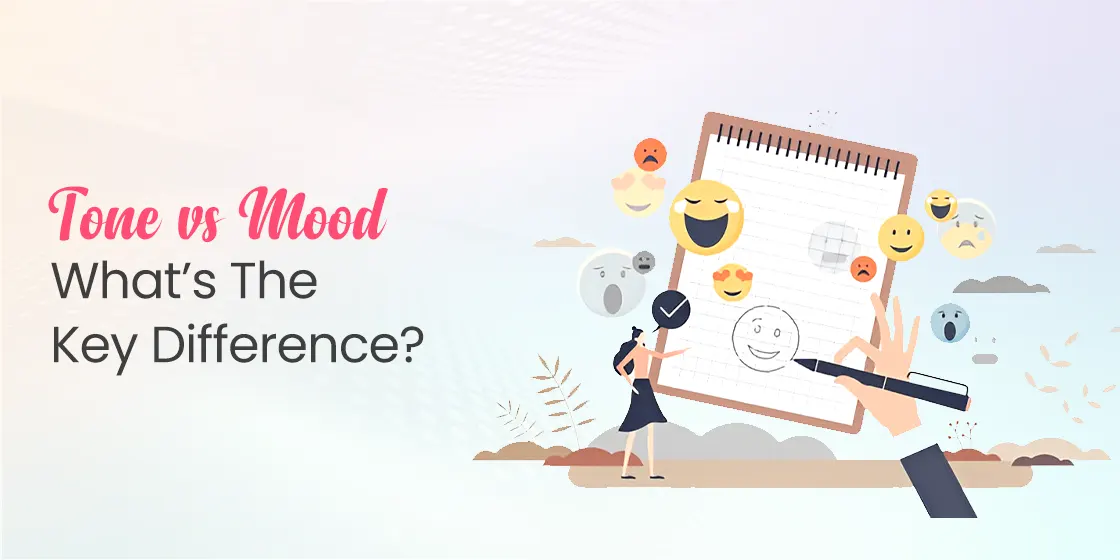Table of Content
Know How Both Writing Techniques Differ From Each Other
Authors use various literary techniques to engage and communicate with their readers, and two of the most significant are mood and tone. These elements help shape the reader’s experience and interpretation of a narrative. By carefully selecting words, and sentence structure, writers can guide the audience’s emotional response within the story. Understanding these tools is essential to offer quality article writing services because clients demand such characteristics in the content.
Mood refers to the atmosphere or emotional setting created by a piece of writing. It is how the reader feels while engaging with the text, often influenced by descriptive language, setting, and events. The mood can shift throughout a narrative to reflect changes in the plot or the characters’ situations, playing a central role in shaping the overall emotional arc.
Tone, on the other hand, is the author’s attitude toward the subject matter or the audience. It is conveyed through word choice, sentence structure, and stylistic elements, and it reveals the author’s perspective or feelings. A sarcastic tone can indicate criticism or irony, while a reverent tone might suggest admiration or solemnity.
If you want to learn more about the differences between tone vs mood, this article would prove to be a good source to you. It will let you know the basics of both techniques, as how they should be used to make the writing more persuasive and engaging.
What is Tone in Writing?

Tone in written content refers to the attitude or approach that the writer conveys through their choice of power words and style. It reflects how the author feels about the subject matter or the audience and can significantly influence how the message is received. Tone can range from formal to informal, serious to humorous, or respectful to sarcastic, depending on the writer’s intent and the context of the writing.
This aspect of writing plays a crucial role in shaping the reader’s understanding and emotional response. For example, a compassionate tone can evoke empathy and trust, while a critical tone might provoke thought or challenge the reader’s perspective. Tone helps establish the relationship between the writer and the reader, setting the mood for how the information is interpreted and creating a framework for communication.
As an essential element of writing style, tone works in conjunction with other stylistic choices like diction, syntax, and punctuation. Writers must be intentional and consistent with their tone to ensure clarity and coherence throughout the piece. Whether in fiction, academic writing, journalism, or everyday communication, a well-chosen tone enhances the effectiveness of the message and helps the reader engage with the content on a deeper level.
What is Mood in Writing?

Mood is a broader and more encompassing concept than tone. While tone reflects the author’s specific attitude toward the subject or audience, mood refers to the overall emotional atmosphere that a piece of writing creates for the reader. It is the feeling or emotional response that the audience experiences as they engage with the persuasive topics. Mood is shaped by various elements such as setting, imagery, dialogue, and the progression of events within the narrative.
Unlike tone, mood tends to remain more consistent over a larger portion of the text. It establishes the emotional landscape that surrounds the characters and events, allowing readers to immerse themselves in the world the author has created. For instance, a story set in a dark forest with descriptions of eerie silence might evoke a mood of suspense or fear. This mood helps to sustain emotional engagement and provides a deeper layer of meaning to the narrative.
Writers use mood to enhance the reader’s experience by aligning the emotional setting with the themes and developments of the story. While tone can be thought of as the author’s voice or expression, mood acts more like the emotional backdrop against which the story unfolds. Recognizing and analyzing mood allows readers to better understand the emotional impact of the writing and to connect more fully with the characters, events, and underlying messages of the work.
Why Writers Need to Understand Both?

Writers need to have a strong understanding of tone and mood because these elements are essential in shaping how their message is interpreted by readers. Tone reflects the writer’s attitude toward the subject or audience and influences the emotional texture of the writing. If a writer chooses the wrong tone, it can lead to confusion, weakening the impact of the piece. A clear and consistent tone helps to build trust with the audience, and reinforce the purpose of the writing.
Similarly, a firm grasp of mood allows writers to craft a specific emotional environment that supports the story or message they aim to convey. Mood engage readers on a deeper, emotional level, drawing them into the world of the text and helping them connect with characters, settings, and themes. Without careful control of mood, the emotional experience of the reader may become disjointed or ineffective.
Example of Tone in Writing
Every writer needs to understand how to build and present a tone in writing. It can be better understood by assessing examples. Let’s take a look at an example how a specific ‘uplifting tone’ can be achieved in writing.
“The sun peeked through the morning clouds, casting a gentle golden light over the rooftops and quiet streets. A soft breeze stirred the leaves, whispering promises of change and renewal. Maria stood by the window, coffee in hand, and watched the world slowly wake up. There was something different about today—something brighter. After months of uncertainty, she finally felt a sense of calm washing over her, as if the weight she had been carrying was beginning to lift.
Downstairs, the radio played a familiar tune, and the smell of warm bread drifted through the kitchen. Small things—ordinary and easily overlooked—suddenly felt significant. Maria smiled, reminded that hope doesn’t always arrive with fireworks; sometimes it comes softly, in sunlight and song. There was still work to be done and challenges ahead, but for the first time in a long while, she believed things could get better. The day was just beginning, and so was she.”
Example of Mood in Writing
Just like the above example, we will explain how you can achieve a particular mood in writing. It basically refers to a whole plot of writing that focuses on a particular context. Below, we have listed a couple of paragraphs focusing on a dark, eerie mood of writing.
“The fog clung to the trees like a heavy curtain, muffling every sound except the slow crunch of footsteps on the damp forest floor. Branches twisted above like skeletal fingers, blocking what little light filtered through the gray sky. The air was thick, cold, and still—as though the forest itself were holding its breath. Somewhere in the distance, a low rustle echoed, but when she turned, nothing was there. Every shadow seemed to shift, every silence felt like it was listening.
She moved carefully, each step more uncertain than the last. A narrow path wound between the trees, almost disappearing into the mist, and she followed it, drawn by something she couldn’t name. The deeper she walked, the more the world behind her seemed to vanish, swallowed by the fog. It wasn’t fear exactly that gripped her, but something colder—an uneasy knowing that she wasn’t truly alone. The woods were watching, waiting, and whatever lay ahead was not meant to be found easily.”
Frequently Asked Questions
| What is tone in writing? Tone in writing is the author’s attitude toward the subject, or characters, expressed through word choice and style. It shapes how the reader emotionally interprets the message. |
| What is mood in writing? Mood in writing is the overall emotional atmosphere or feeling that a piece creates for the reader. It is shaped by setting, imagery, and language to evoke specific emotions. |
| What is a conversational tone? A conversational tone is a relaxed, informal style of writing that mimics everyday speech. It helps create a friendly, approachable connection between the writer and the reader. |
Final Words
That brings us to the end of this blog in which we have discussed key differences between tone vs mood in writing. As a writer, you need to have a firm understanding of both writing techniques. They become useful in various scenarios where a particular projection of content is needed. From articles to eBooks, the tone and mood of writing helps to shape up different forms of content. It is therefore advised to understand the technicalities of both, so that copywriting skills and expertise can get enhanced on a broader level.

Unleash your brand story`s potential with eContentSol – your creative writing companion. We craft narratives that captivate. Ready to elevate your content game? Dive into creativity with us and let`s bring your ideas to life.


